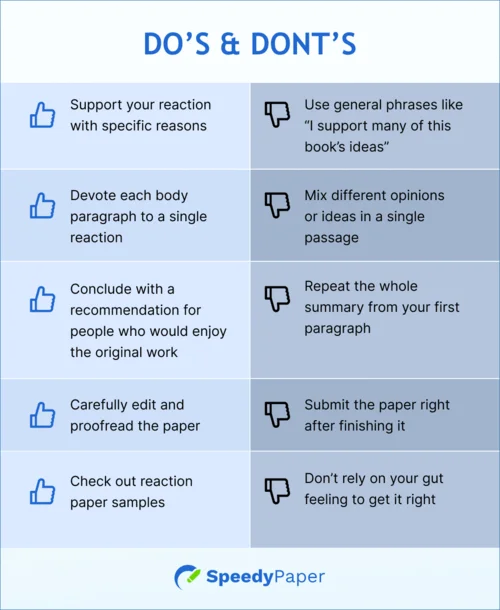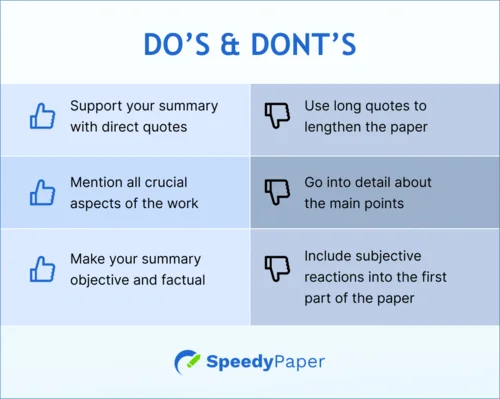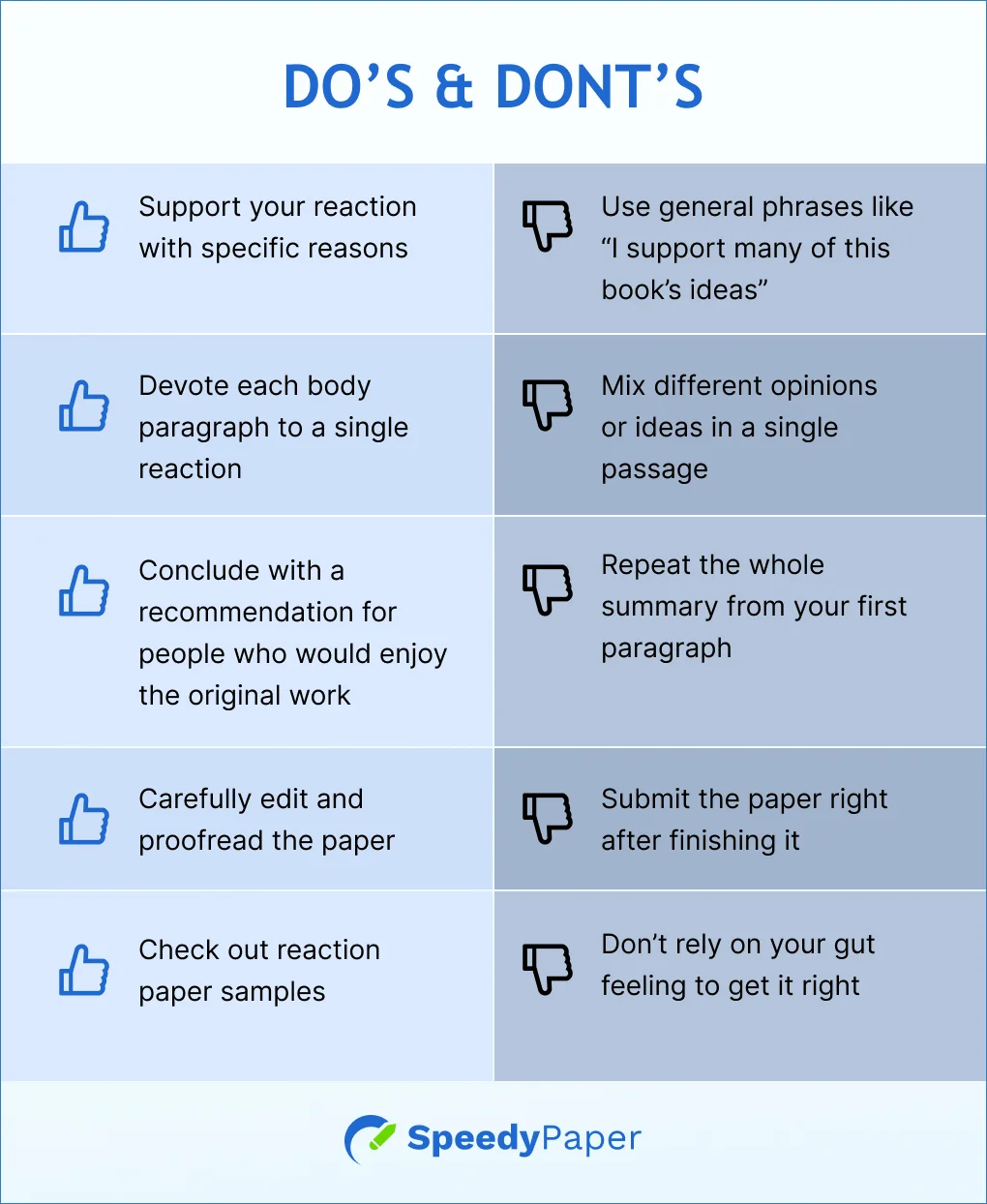
How to write a reaction paper: guide + topics
|
Table of contents: |
As a college student, you should know everything about the challenges of writing a response paper. Thus, finding effective ways to deal with the assignment is exactly what most learners need for the successful completion of the project.
A response paper, which is also known as a reaction paper, is an important type of academic assignment aimed to emphasize the student’s ability to analyze a certain piece of writing and come up with meaningful conclusions. Response essay writing is not easy, but only if you lack influential guidelines, inspirational topic ideas, and effective tips. Whether you need help with a response paper or a more complex project, such as a dissertation, utilizing a dissertation writing service can provide you with the necessary support and expertise.
Tip from SpeedyPaper:
Deal with definitions first so that you are aware of the essay specifications and peculiarities that may influence your work and its results.
What is a reaction paper? Why write it?
A reaction paper is just what it says on the box: your written reaction to a book, an article, a TV show, or a movie. Still, many students struggle with this type of paper, even if they know this simple answer to the question: What is a reaction paper? There is no need to deal with definitions and specifications of the essay if you choose to hire a Speedy Paper helper. Nonetheless, if you are ready to accept the challenge and expand your vision, the following information may be critical.
The trouble is that many students confuse reaction papers with online reviews, book summaries, and research papers that serve different purposes and require other approaches to writing. Instead of focusing solely on your experience, retelling the storyline, or analyzing what others say about the same work, you need to combine all three into a cohesive piece.Why do such papers have a positive effect on student performance?
Writing reaction papers provides excellent mental gymnastics for students. They demand critical thinking, fostering the ability to analyze, compare, and interpret text or events. Moreover, in writing such papers, students sometimes seek assistance from our best law essay writing service, thus enhancing their writing skills and broadening their perspectives. Essentially, it's a two-pronged approach to academic growth.
How to write a reaction or response paper
Writing reaction papers is excellent practice for giving useful feedback, a skill you will require after getting your first job. This assignment trains you to provide hard evidence to support your opinions while at the same time convincing others of the credibility of your point of view. Think of all the ways these skills will help you when you need to give feedback to your coworkers or subordinates, and you’ll see the value of learning how to write a reaction paper.
If you can’t wrap your head around this seemingly easy assignment without getting outside paper help, you are in luck! We have prepared a detailed guide for you to follow. And you can also read a reaction paper example or two in our database.
Read the original paper
Before you start working on a response paper, you should understand the reasons for your writing. What are you reacting to? What is your goal? What is your perspective? Take your time to analyze the work and acknowledge the main ideas specified there. Make notes as you work with the original text, read multiple most inspiring response essay topics, and brainstorm information that will help you thrive with your custom paper.
Come up with a thesis statement
Are you done with the preparatory stage? It is time to start working on the introductory part of your response paper. A thesis statement is undeniably the critical part of your essay, as it presents your perspective and gives a better understanding of your angle. How is it possible to come up with a short, logical, and meaningful thesis statement? Analyze the topic of your work, read the notes you made once again, and summarize the core concepts in a single sentence.
Create the outline
Then comes the most challenging part of the project. At this point, you should make maximum effort to develop a meaningful, structured, and relevant plan for your further response paper writing. Working on the outline, you should take into account the structure of the academic essay, its peculiarities, and key requirements. Come up with the most significant ideas, dividing your text into the introduction, body, and conclusion. If you succeed with the outline, writing a response paper will not take you much time.
Tip from SpeedyPaper:
Do not start writing an essay unless you create a well-structured outline, as it will most likely lead to failure.
Work of the first draft
Follow the structure specified in the outline, expanding the ideas, adding examples, and giving evidence to prove your point of you. Mind the formatting and structure of the response paper to keep it relevant and influential.
Proofread the paper
Before you complete a reaction paper, you need to double-check it for mistakes, typos, and inaccuracies that can affect the quality of the work. Edit the first draft so that you get a flawless response essay with zero issues.
Reaction paper format and outline
If you’ve ever sneaked a peek at a professor’s rubric, you know structure and format are among the core requirements for any paper type. If you turn in a rant filled with sidenotes that’s extra hard to read because of a tiny, elaborate font, you won’t get any brownie points from your professor.
Your pre-writing routine should start with asking the right questions:
- How long does your paper need to be?
- What is the appropriate format?
- How many secondary sources do you need to cite?
Once you know the right word count, you can work on your reaction paper outline. The introduction and conclusion are usually one or two passages long, up to 150 to 200 words each. Deduct the appropriate number from the desired word count and divide by the number of core points you wish to make, and you get an approximate length for each of the body paragraphs your reaction paper will have. For maximum impact, make your first and last body passages the strongest, and sandwich your weakest points between them.
Once you get a clear answer on the appropriate formatting style, look up the guidelines online. APA, MLA, Harvard, Chicago, and other styles have lots of tiny details that make them difficult to cover in a short blog post. If you’re unsure where to begin, look up the font size, line spacing, and page margins. These alone will make your paper look good, though using the right title page layout is also important to make a great first impression.
Start by summarizing the work in the introduction
You don’t have to rack your brain wondering how to start a reaction paper. It’s quite simple: the first part of a reaction paper template is usually one or two paragraphs long. This section should answer the question: What are you reacting to? Your introductory passage should include the title of the work and its author. Provide publishing information according to your instructor’s requirements.
Create a summary of the work, highlighting its main ideas and supporting points. Your readers should be able to get a general idea of the work you are describing. Think of this paragraph as a short abstract.
Dos and don’ts:
- Support your summary with direct quotes, if necessary. Don’t provide lengthy quotations that will artificially increase the volume of your paper.
- Mention all crucial aspects of the work. Don’t go into great detail about any of the main points.
- Make your summary objective and factual. Don’t include your subjective reaction to the work in the first part of the paper; you will have plenty of room for that later.
Describe and analyze your reaction in the body paragraphs
Depending on the reaction paper format you have been assigned, the second part will consist of two or more paragraphs and deal with your analysis and reaction to the original work. You should quickly analyze the work’s structure and main points without turning your reaction paper into a critical analysis essay. You can discuss whether the writing was convincing, whether it was balanced or biased, well-researched or based purely on conjecture.
You can discuss many aspects of the original work and your reaction. The goal here is to share a personal experience with the readers. To help you better structure your thoughts and make your writing more streamlined, check out our list of questions. Ask your instructor which answers you should expand on in the reaction paper.
- Did you find the work exciting or boring?
- Did the piece stir strong emotions in you? If so, which feelings were they?
- Did you come to any realizations after reading the work?
- Did the piece raise any questions for you?
- Did the work relate to your experience, ideas, and feelings?
- Did the work influence your perspective on the issues described in it?
- Is the piece still relevant in modern-day and age?
- How is the work related to the material you have studied during the course for which you are writing a reaction paper?
- Writing a reaction paper is easier than most assignments. However, it can still bring you bad grades if you don’t pay attention to the rules of good writing. Here are some quick reminders before you start writing.

Dos and don’ts:
- Support your reaction, ideas, and thoughts on the work with specific reasons; detail them for every paragraph. Don’t use general unsubstantiated phrases, such as ‘I support many of this book’s ideas’.
- Devote each body paragraph to a single reaction, supporting it through additional details or examples. Don’t mix different opinions or ideas in a single passage; this will make your writing confusing and sloppy.
- Check out a reaction paper sample or two in our base to get a better understanding of the format and style you should use. Don’t rely on your gut feeling to get it right.
Include final thoughts and recommendations in the conclusion
Writing a reaction paper cannot be finished without a strong conclusion. Instead of paraphrasing the introduction, include a couple of parting thoughts or ideas that occurred to you and that you wish others to remember. You can also include a recommendation, highlighting groups of people who might enjoy the work as much as you did. Alternatively, you may list a couple of relevant works that invoked similar reactions in you and recommend them to those who share your opinion.
Dos and don’ts:
- Complete your conclusion with recommendations for people who would enjoy the original work. Don’t repeat the full summary from your first paragraph.
- Set aside some time for careful editing and proofreading to weed out inconsistencies in your writing. Don’t submit the paper immediately after you have finished writing it.
Formatting is key in writing a perfect reference list
Regardless of the subject of your reaction paper, you need to cite the primary reference, be it a book, an article, a movie, or a work of art. Other entries on your reference list may include similar pieces or secondary sources containing critiques. If you use any quotes, ideas, or data from secondary sources, you must include in-text citations and list them in the reference section.
Pay attention to the required reference style in the assignment prompt and look up appropriate reaction paper guidelines and citation rules. Remember, in-text citations are as important as the reference list, and you must include all pertinent publication information according to the formatting style guide. We recommend using automatic citation generators as long as you take your time checking every entry to ensure they match your sources.
Reaction or response essay topics
Writing a response essay that will impress readers is much simpler with a relevant and up-to-date topic. Here are a few ideas that may inspire you and help you with the choice.
- Positive and negative outcomes of stress analyzed
- Excellent speaking skills of James Baldwins: The Secret of Success
- Battle Hymn of the Tiger Mother by Amy Chua
- Electric Tram Rides from Forster Square, Bradford: critical response to the movie
- The basics of reading response: coming up with flawless results
- The Story of an Hour: comprehensive analysis of the text
- Pet allergies: critical response to the article
- Declaration of Independence: its basics and specifications
- Mother Tongue by Amy Tan: features of the most commonly used languages
- The role of sport and recreation in human culture
- Why diversitiesa are upside down: critical analysis and explanations
- Effective ways to respond to rejection letters
- Fast fashion and its peculiarities: How to respond to it
- Two Kinds by Any Tan: Detailed analysis of the work
- Why buy local? Response essay
Tip from SpeedyPaper:
Check out a comprehensive database of SpeedyPaper topic ideas to enrich your vision and choose a relevant topic for your essay in no time.
Make the most of our reaction paper example library
Are you still struggling with a reaction paper? If our advice doesn’t help, maybe its practical application will. Check out the examples of reaction paper in our library, and see our tricks put to use by your fellow students. Use the search bar to find samples for your class and topic, or browse the category to get inspired and find good ideas for your assignment. We encourage you to borrow ideas, outlines, arguments, references, and more from our examples database. As long as you don’t try to turn in any of the samples as your work, you should be perfectly safe. Remember, students wrote most of our sample papers, so be on the lookout for typos and small mistakes to avoid transferring them to your piece.
And if you are tired of tedious writing, order an essay online and make the most of your student life while our writers pick up the slack and complete this assignment for you.
Additionally, there is always an opportunity to simplify the process of writing a response paper. Take your time to check out the sample essays available below, as they may serve as an excellent source of inspiration, ideas, and writing tips. Focus on the most relevant and suitable response paper examples so that you succeed with your custom work stress-free.
Tip from SpeedyPaper:
Reading sample papers will not only help you understand the structure of the paper but will also provide you with unlimited writing tips that will contribute to the quality of your writing.
Conclusion
Have you read the guidelines on how to write a response paper carefully? Are you ready to dive into the process? Look through an extensive database of response paper samples and topic ideas that will aid the completion of your assignment and will draw you closer to the desired results.
The good news is that by surfing the SpeedyPaper website, you will find assistance with other types of academic projects. Comprehensive guidelines on how to write an analytical essay and other types of college papers are always beneficial.
Finally, if you continue struggling with the paper, entrust it to our professionals. Fill in the order form, and specify the requirements for the essay, including the deadline, academic level, and other specifications so that you get your impeccable paper on time.




Comments (0)
Thank you for your comment! 🌟
It has been submitted and is awaiting moderation. Stay tuned—it will be visible soon!